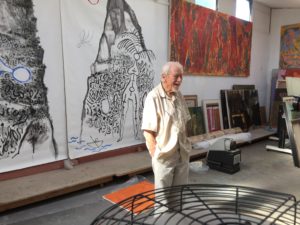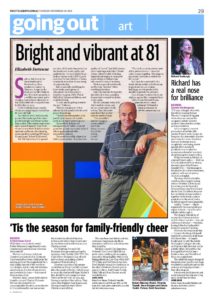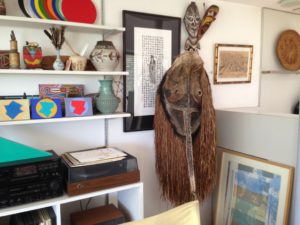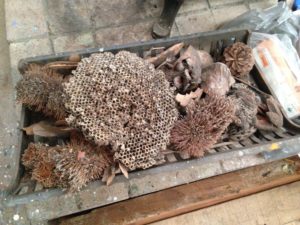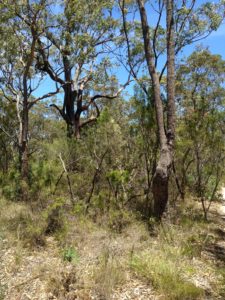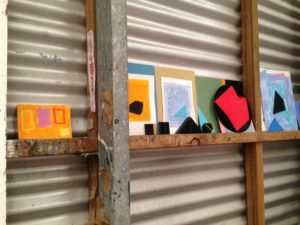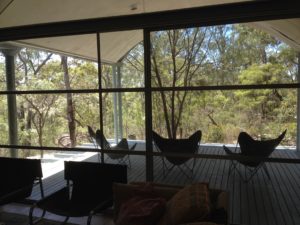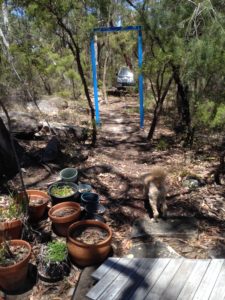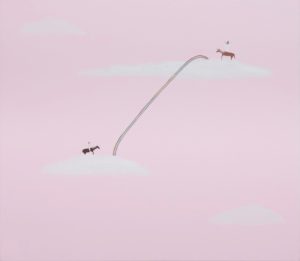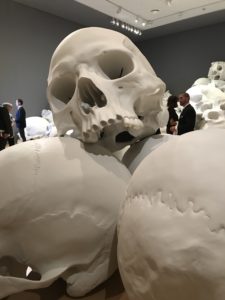News
Guy Warren: a visit to the great Australian artist’s studio
Apr 9th
On March 7, 2016, I was fortunate to visit Guy Warren at his longtime studio in Sydney’s inner suburban Leichhardt.
The purpose for my visit was the story I was writing for the Daily Telegraph about Guy’s upcoming exhibition at the S.H. Ervin Gallery, titled Genesis of a Painter: Guy Warren at 95.
Here’s an edited transcript of our wonderful interview. It seems we started off talking about the Depression era.
Guy Warren: My memory of Sydney in those days was a muso on every street corner busking for a living. And the Manly ferries had musos on them. Each Manly ferry had a piano on board, so there was a pianist, there was usually a violinist, or a banjo player. Or a cornet or something like that. And someone used to take the hat around before they got to Manly. It was a tough life.
I asked Guy how the S.H. Ervin Gallery exhibition had come about.
You know Barry Pearce [emeritus curator of the Art Gallery of NSW]? It’s all Barry’s fault. At a dinner one night I was sitting next to Barry and I said ‘well the major problem I’ve got now is deciding what to keep and what to chuck out. I can’t leave a lot of rubbish behind me. I can’t leave it to the kids, they won’t know. So I’d better decide what to keep and what to chuck out’, and he said ‘oh I’ll come and help you’. So he came and he started pulling things out from that corner over there and he kept saying things like, ‘oh, these are great, oh, these can’t be chucked out, oh, I’ve never seen these before. Have these ever been shown?’ He said, ‘for the first time I can see where you’ve come from. I could see the connection between then and now’. So he thought having a show called Then and Now, so it will be old works and new works. So it’s not a retrospective because there’s nothing in the middle. It’s just then and now. I think it’s a great idea. Because he hopes, and I do too, that people can see the visual connections and the conceptual connections. Ideas that link through and images that link through.
Were you going to throw away some of the ones Barry liked?
They could very well have been. Some I haven’t seen for 60 years. There are things here that are done in the mid 50s.
We discussed Guy’s routine, and he told me he gets into the studio about 10am and works until 6pm or 7pm.
That’s the best days. There are days when it’s not so good and I leave earlier.
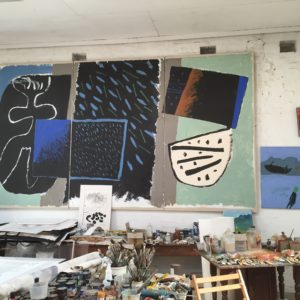
A corner of Guy Warren’s studio. Picture: Elizabeth Fortescue
I explained that the story angle I had in mind was how art keeps you young.
Well I’m not sure it’s art that keeps you young, it’s curiosity I’ve decided. And I think that probably applies to just about everybody. You’re curious to see what’s around the corner. That must be the thing that keeps a scientist going. Wonder what would happen if I do this. I wonder if I can solve that problem by doing this.
Artists are enormously curious, I said to Guy.
Well you never know what the painting’s going to look like until you do it. You might think you’re going to know, you might think you’ve got an idea, but you don’t know until you’ve done it. I remember one eminent American painter, Philip Guston I think, who talks about much the same sort of thing because he never knew what was going to happen until he did it and he said oh that’s what it looks like. And that’s exactly it.
Not everybody works the same way, but if I have an idea it may or may not end up looking like that idea because it’s a conversation you have been you and the painting. Sometimes the painting speaks to you and says, do this. Musicians do the same.
I reminded Guy of his travels to Ecuador in 2013, and suggested it was curiosity that took him there.
I did it because I had a friend [artist Charles Reddington] over there and he invited me over there. My son [Paul] and I went over there. I’d never been to South America before. The Andes, it was fantastic.
What did you do in Ecuador?
I like rainforest country so I went to a place called Cloud Forest which is like rainforest but very high which was extraordinary. Much the same plants that we have here in our rainforest, but twice the size, three times the size. And we ended up in the Galapagos. That was fun. Lots of huge tortoises. The oldest one had recently died. I think they called him Old George. Notices were pinned in all sorts of places, sometimes on trees, which said, you know, goodbye Old George. So he was obviously very popular with tourists, I guess.
Did you do any drawing?
Yes I always carry sketchbooks with me, and I’ve done some paintings since then. (Probably not going in the show.) Not quite relevant to what Barry sees as the main theme of the show.
I’ve been to London and Berlin but that was when my wife was alive. The trouble with getting old is that those things that happened a few years ago, you always think was about two years ago, as a matter of fact when you look it up you find it’s 10 or 20. Time just collapses.
In your wife Joy you had a great mate to be curious with.
Yes, she was. She was a very good ceramicist. That girl got her PhD in her 70s. That’s pretty good, isn’t it. I think it’s bloody amazing. I guess she was curious, she had to be. She had a very good teaching career. She was a damn good ceramicist, too. Made beautiful pots.
Where was her studio?
At home, under the house. The house we bought many years ago had a bit of an area underneath and I borrowed a jackhammer and jackhammered the rock out and she carried it out on a wheelbarrow. It was a joint activity and we made a nice little pottery for her.
I do have another studio at home, not as big as this, but I do a lot of work there. A lot of drawing, sketching, a lot of watercolours.
We discussed how long Guy had been in his Leichhardt studio. He had been in it for 30 years. Before that his studio was an old boat repair shop in the last street on your left as you head towards the end of Darling St, Balmain. Guy was there for almost 10 years while he was also teaching at Sydney College of the Arts. He’d be teaching at the SCA campus then go to the waterfront studio at lunchtime to do a bit of work on a watercolour or something, then return to the SCA for the afternoon sessions.
You had a long teaching career. Did it help keep you going?
I think so, because you’re dealing with ideas. I taught for a long time in the architecture faculty and Sydney University and at the Tin Sheds, and you’re dealing with people who had fantastic information and knowledge about all sorts of things. Teaching is great when you’re learning at the same time. If you can learn as much as you teach, I think it’s marvellous.
It’s stimulating to be among other artists?
Yes, some of my life I had to get other jobs in commerce but most artists do. Certainly in my generation because other jobs weren’t available in those days. Even Lloyd Rees worked in commerce for a long time. I taught with him at Sydney University. I remember him saying the first day that I started teaching with him. He looked at me seriously and he said, ‘Guy if you have ever worked in commerce as I know you have, and as indeed I have in the past, there will come a time as a teacher when you may think you’re not earning your money’. He said, ‘don’t let it worry you’. Then he went on to say that a lot of the teaching takes place in other activities, when you’re talking to students. You know, you don’t have to be teaching. Teaching is about talking to people and discussing ideas, and I think that is what he was talking about. Because Lloyd was that sort of bloke. He was a people person. He welcomed talking to people.
I wouldn’t have been teaching without Lloyd. I bumped into him going home on the bus one night and he asked me would I like to come and help him teach the architecture students. I think he was teaching them drawing. And I was working with an advertising agency at the time, and I thought, hell, it’s a lot better than that.
What were you doing at the ad agency?
A non creative job. I deliberately asked for a non creative job. I’d been away from Australia for eight years. And when I came home I did not want to get into commercial art because it makes you slick and makes you think in a particular way. Worrying about other people’s problems and trying to satisfy the client instead of trying to satisfy yourself. (He had an organising job, organising ads for Nestle and Victa mowers among other things.) I think I’ve probably tried to forget them, but I remember those two. (Guy said he commissioned photographers and artists to do work, and was responsible for everything being done properly. It was a visual job, but not a creative one.) I stayed there for a few years until I started teaching with Lloyd.
In your life, have you done a lot of travel?
I’ve been to Europe a few times and I lived in London for eight years and did a lot of travel while I was there. I hadn’t travelled much in Australia. I’d been to New Guinea of course. And I hitchhiked around Australia with a friend.
David Attenborough had once bought one of Guy’s paintings and I asked if he had ever been in touch with Attenborough again.
Oh yes, I have. The last time was because I saw an interview Andrew Denton. Denton did the interview in [Attenborough’s] lounge room and there was my painting on the wall.
That was probably the time I rang Attenborough over something and asked him how he was going on, and he said, ‘oh, not too bad, not too bad, it is getting a little more difficult to climb trees’. He must have been 80 then. It’s about having a passion and curiosity.
I asked a question about whether art can be a good thing for people when they retire (don’t forget that my story angle was about how art can keep you young). Guy snorted!
Retirement is a stupid bloody word. People think that means they sit on their backsides and don’t do anything. That’s probably the first time in their lives when they have the opportunity to do what they want to do. The word retirement ought to be banned. I refuse to retire.
They say that to me. They say that to every artist. Are you still painting? As though it’s something you can drop. Of course I am, I mean what would I do? It keeps me off the streets.
Can art have a role in people’s lives after work?
I guess it can, but they have to be interested enough to want to do it. And that’s the only problem. I remember talking to somebody once who was CEO of a major international company and he said, ‘oh gee, you’re lucky being a painter. Never mind, when I retire I’m going to learn the flute or the oboe or something’. And I thought, ‘well that would be a great idea, but you can’t leave it too long because you need to start that earlier’. But certainly you don’t have to make art if you don’t want to. But you can learn about art. You can go to plenty of lectures. But people do other things. I’m sure they go to lectures about theatre or science or music.
Your S.H. Ervin exhibition is called Guy Warren at 95: Genesis of a Painter. It includes works from the 1950s and 1960s, as well as contemporary works.
He (Barry Pearce) said I can see for the first time where you’ve come from, and he meant not only the images but the ideas as well. And that was a nice thing to say. The other thing that happens is the concept frequently remains the same but you might try it in a different way, so the envelope might change but the contents are clearly related, and that’s something people might see in this show.
What are the most recent things in the show?
Things I showed with Olsen Irwin last year. An odd collection of paintings and I called them Dust of Memory because that’s what they were. But they’re all new paintings.
Barry Pearce sourced all the older works from Guy’s studio. Some of the pictures were still there, and I noticed that one of them had a post-it note stuck to it, saying ‘Guy to clean’. I asked Guy if the older works had required conservation or anything.
I’ve refurbished some of them but not all and I refuse to have them reframed. If they’re old works then maybe they should be seen in their old frames.
Guy said the journalist Scott Bevan was doing an interview with him to be screened in the gallery at the exhibition.
He did an interview with me years ago, well when I was 90, I think. Five years ago. My god!
Posted by Elizabeth Fortescue, April 9, 2020

Harrie Fasher, Beersheba and Sculpture by the Sea 2017
Dec 28th
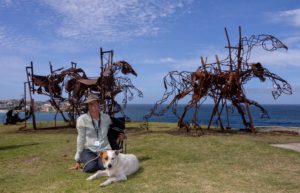
Harrie Fasher with her biggest sculpture to date, The Last Charge, at Sculpture by the Sea in Bondi, Australia, 2017. Image courtesy of Sculpture by the Sea.
This year I had a great interview with rural NSW artist Harrie Fasher about her work for Sculpture by the Sea, titled The Last Charge.
The story was for the Daily Telegraph, and you can see it here.
For the record, however, here’s the interview in full.
Elizabeth Fortescue: Harrie, what materials did you use for The Last Charge?
Harrie Fasher: Corten steel and mild steel.
EF: Did you use oxyacetylene to put it together?
HF: This has been a real battle. It also has industrial I-beams and RHS which is rectangular square section. It’s MIG-welded together and plasma cut. Then ground back using angle grinders.
EF: It sounds very physical.
HF: We’re up and down off the scaffold and the other day I was having a joke about going to step classes at the gym. It is a hugely physical process. There’s no way I could do it alone. I’ve got a team with me in the studio. I’ve got a studio assistant, Megan. She’s been working with me for three and a half years. My farmer next door has been (helping). It’s been very much a team effort. Every artist needs a farmer, is our joke. I live in the middle of a working farm. He’ll help me twist the I-beams or we were heating pieces of steel in a bonfire at one point and he was whacking it with a sledgehammer whilst I was moving it on the chopping block. He has no previous art experience. He’s not overly engaged with the art. But everybody wants to be a part of it. It’s this amazing thing that so many people want to be a part of making art. It blows me away.
EF: Has he helped you with other works for SxS?
HF: Yeah, he’s always helping me. He brings down the tractor so we can move stuff around and load trucks. Metal Land in Bathurst sponsors me and gives me a fair chunk of the steel that goes towards SxS and they lend me their truck. This time it’s going to take two trucks to get it to Bondi. This will be the fourth Bondi that they’ve been involved in. They love it. I don’t know if it’s just a rural thing that there’s all these people that want to be involved in it, but there’s a woman I went to art school with and she lives at O’Connell and she comes whenever she can and cuts pieces. It blows me away how many people want to be a part of things like this. I have a huge network. I think sculptors need friends. I can’t move the sculptures by myself.
EF: What’s the farmer’s name?
HF: Geoff Salmon. And Steve Hogan was my first farmer. (Now he’s making his own sculptures.) He does one or two days a week (for me).
EF: Tell me about your assistant.
HF: My assistant is Nicole O’Regan. She’s a steel fabricator by trade. She’s two years younger than me. Been working with steel since she was 16. Working with another woman is just fabulous. Working with men is quite different. You constantly have to assert yourself a little bit. She’s a crucial part of my team.
EF: How far from Geoff, the farmer, do you live?
HF: I live in the middle of his property of 1200 acres at Oberon. I live in the middle on 12 acres on a property called Essington Park owned by the Logue twins, Joanna Logue and Simone Logue. King Street (King Street Gallery on William) have just taken me on board. I’m going to have my first solo show with them in June. Joanna has the other half of the studio I’m in. The girls’ block, Essington Park, is in the middle of Geoff’s place called Ambleside. Geoff’s son Tim now manages the family property. Sheep and cattle.
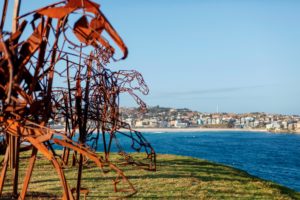
The Last Charge, by Harrie Fasher. Sculpture by the Sea, 2017. Image courtesy of Sculpture by the Sea.
EF: Tell me about The Last Charge.
HF: Eight horses, slightly larger than life. I don’t think I knew what I was taking on. Seven of them are in full gallop. I started the project with a maquette, but I started without a notion of how it was going to look. I wanted to create an emotional response which is to feel what it would have been like to face a full cavalry charge, being over-run, what it would have felt like to be in the Turkish trenches and have these 800 horses galloping at you. And at first I thought I’d make 800 and fill Tamarama Beach and then I thought that would be a bit ludicrous but in reality eight is quite a lot.
One of the horses is fallen. That horse has a real beauty about it. Something quite poetic about the fallen horse. Sometimes I relate to them and I feel them as the men. My mum’s always told me not to anthropomorphise my dogs, but I think I do that with the sculptures. The sculptures are the men, and they embody all these different characteristics that go into making up the myth that’s become part of the Australian culture. They have the courage and the fear and the determination, but they also have a strange ghostliness. Some days I relate to them as this powerful, charging, conquering mass of horses and some days I relate to them as being ghostly.
It was a very successful charge, and one of the only ones because the Light Horsemen actually fought on foot. One person would hold five horses and the rest would fight on foot. Rarely held an old fashioned cavalry charge. It meant the Turkish weren’t able to realign their gun sights. They weren’t prepared for them. The horses were desperate (thirsty). If they didn’t take the town they had a 12-hour ride to water, and there’s that real thing about survival where the men depended on the horses as much as the horses depended on the men. There’s great stories about horses falling in battle and the men then retaliating in revenge for the horse.
EF: All the horses had to be shot at the end of the war, because they couldn’t be brought back home to Australia.
HF: I’ve read how calm it was when they put them down but because the horses trusted the men so much and they were used to gunfire, there wasn’t any panic. They cut their manes and tails and took their shoes off, and hides, because all of that was worth money to the army. Can you imagine skinning your own horse? It would have been heart-breaking. All the time you’d be thinking, ‘oh when I get back with my horse’. People do ask me why I have to have a dead one, a dying one, and I say ‘well it’s a reality check. War isn’t pretty’.
EF: You have two horses on the farm, Dusty and Evie. Did you use them as models for your sculpture?
(Harrie said she saves pictures from the form guide, and also uses horse books.)
EF: Tell me about your forebear who was in the Battle of Beersheba.
HF: Major Lachlan Alfred Macpherson, (known as Alf). He was mum’s great uncle so he was my great great uncle. Born in 1884. We have portraits of him in uniform. I have his medals which I wear on Anzac Day. He won an MC and a DSO. He was at the Battle of Beersheba. The eighth Australian Light Horse. He fought everywhere. He survived the war and came home and settled near Goulburn. I think he was near Gundagai before he went to war. On a property where he grew up. We’ve only just started investigating this connection. It is rather amazing. I went to France on a field trip with a whole lot of landscape painters from King St and Stella Downer and Watters. In May. We were going to do an exhibition on the Western Front. France and Belgium. It gave you a real insight into what they faced and how impossible it was, the missions they were on.
EF: Do you sometimes help Geoff on the farm, the same as he helps you with your sculptures?
HF: Geoff asked me to come and help him pull a cow out of a bog.
EF: Did you get it out?
HF: Yep. She’s out.
Posted by Elizabeth Fortescue on December 28, 2017
Ron Mueck discusses his NGV Triennial installation titled Mass
Dec 27th
For those who are travelling to the NGV Triennial at the National Gallery of Victoria (and you won’t be disappointed) one of the most ambitious works to enjoy is Ron Mueck’s largest installation to date, a new piece commissioned by the NGV for its inaugural NGV Triennial.
Titled Mass, the piece is comprised of 100 giant-sized skulls positioned within the 17th and 18th Century halls of the NGV. Its impact is huge.
I interviewed Mueck for The Art Newspaper, but of course the entire interview could hardly be used in an article. So I reproduce it here for those aficionados who love to hear from the horse’s mouth about an artist’s process and thoughts as they make a work.
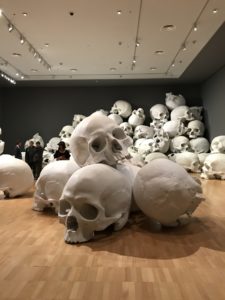
Mass, Ron Mueck’s largest installation to date, is a key work in the inaugural NGV Triennial at the National Gallery of Victoria in Melbourne.
Here’s the interview:
Elizabeth Fortescue: What are the skulls in Mass made from?
Ron Mueck: The skulls are made of fibreglass and polyester resin.
EF: Were you able to make them yourself in your studio?
RM: The short answer is: I started them in the UK and they were completed in Melbourne. The long winded version is: I started the project in my studio in the UK where I sculpted the original skull in water based clay and made a couple of silicone moulds that would ultimately be used to cast multiple copies.
Initially I cast five skulls from these moulds to ensure they worked and to determine the best process and materials.
Because the original clay model gets destroyed in the moulding process, I cast out a ‘master skull’ in resin to make additional moulds from.
This master skull and the two moulds were shipped to Australia.
While we were making the moulds, the NGV were looking into setting up a workshop in Melbourne where the skulls could be produced. This was clearly going to be a better solution than shipping 100 large scale sculptures halfway across the world.
We looked at a few different possible set ups and ultimately decided it would be best to work with an established, specialist fibreglass company with all the necessary facilities in place rather than setting up a workshop from scratch. The NGV found a Melbourne-based company (King’s Fibreglass) who fitted the bill.
I came out to Australia shortly after the moulds and master skull arrived and spent a couple of weeks at King’s working with the skull crew. The skull moulds were quite different to those they usually worked with and we worked through the idiosyncrasies and complications and cast out the first couple of skulls.
Timing was always going to be a major consideration and it became clear that we would need a separate crew dedicated to cleaning up and finishing the casts as they came out of the fibreglass workshop. The NGV put together a group of technicians from their pool of art handlers. Initially there were two but this team expanded to about eight people.
With two moulds it was possible to launch into the casting process but moulds deteriorate as they are used and we knew that we would need additional moulds as the work proceeded. I spent three weeks with another company, Idea Productions, making a third mould and they subsequently made a further two giving us a total of five moulds which meant that at one point there were five, occasionally six skulls being produced a week.
With the production process established I went back to the UK to clean up the studio there and start preliminaries for the next work. Progress reports and images sent to me in the UK kept me up to date. We discussed problems that arose and figured out solutions as necessary but on the whole, due to the talent and dedication of everyone involved, it all ran pretty smoothly.
I arrived back in Oz a couple of weeks before the end of production to join the NGV finishing crew for the final burst of activity.
The Australian end of the project took about eight months.
An extraordinary amount of work achieved to a superb standard by a fantastic team.
EF: Did you use any particular skull as your model for the work?
RM: I made a point of not using a specific skull type. The sex, age and ethnicity of individual skulls is visually apparent and I tried to come up with a somewhat ‘universal skull’ so that the interpretation of the work would not be confined to a particular narrative.
EF: What is the scale of the skulls compared to an actual skull?
RM: I haven’t figured out the exact ratio.
The skulls are about a metre tall sitting on the floor.
I generally just go for what feels right to me when I’m making the work.
I sketched out a couple of different sizes on large sheets of paper, chose the one that felt a good size to stand beside, and then made a three dimensional cardboard mock-up of that size so I could get a sense of it in the round.
EF: Is this your largest work to date?
RM: Yes, although it is a work of variable dimensions. It will be reconfigured each time it is displayed. I imagine the size and atmosphere of each venue will influence the arrangement.
EF: The depiction of the human skull as a memento mori dates back hundreds of years. Can Mass be viewed as a giant memento mori?
RM: Certainly. Memento mori and the vanitas tradition in art remind us of the brevity of life.
EF: Did you have any particular human or world events in mind when you made it? I was reminded of the terrible piles of skulls left behind by Pol Pot’s regime, for example.
RM: Over the years I have collected a number skull images from various sources…from Paul Cézanne’s Pyramid of Skulls to Cambodian killing fields or the catacombs of Paris. These have all played a part in the development of Mass.
by Elizabeth Fortescue, posted on December 27, 2017
Sydney, Australia

